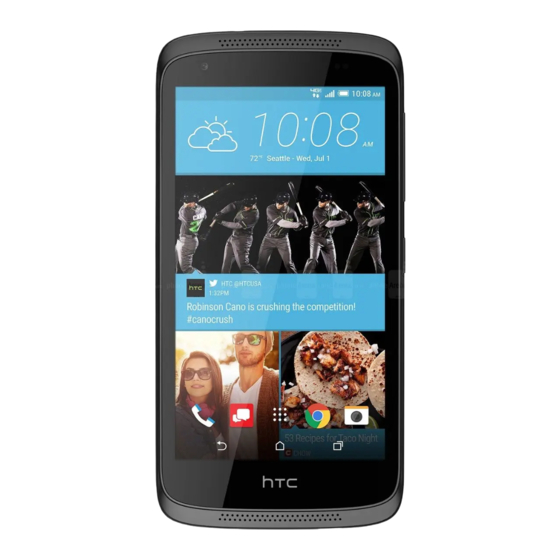HTC DESIRE 526 Manual de serviço - Página 20
Procurar online ou descarregar pdf Manual de serviço para Telemóvel HTC DESIRE 526. HTC DESIRE 526 48 páginas.
Também para HTC DESIRE 526: Conhecer (2 páginas)

and brain tumors ever undertaken. WHO summarized its
conclusions concerning Interphone as follows: "Overall, no
increase in risk of glioma or meningioma was observed with use
of mobile phones. There were suggestions of an increased risk
of glioma at the highest exposure levels, but biases and error
prevent a causal interpretation. The possible effects of long-
term heavy use of mobile phones require further investigation."
The WHO's comments on Interphone are available at: http://
www.iarc.fr/en/media-centre/pr/2010/pdfs/pr200_E.pdf.
WHO's publication of Interphone is available at http://www.
oxfordjournals.org/our_ journals/ije/press_releases/freepdf/
dyq079.pdf; see also, Interphone Appendix 1 (http://ije.
oxfordjournals.org/cgi/data/dyq079/DC1/1), and Appendix 2
(http://ije.oxfordjournals.org/cgi/data/dyq079/DC1/2).
What Does Specific Absorption Rate (SAR) Mean?
In 1996, the FCC, working with the FDA, the U.S. Environmental
Protection Agency (EPA) and other agencies, established RF
exposure safety guidelines for wireless devices in the United
States. Before a wireless device model is available for sale to
the public, it must be tested by the manufacturer and certified
to the FCC that it does not exceed limits established by the FCC.
One of these limits is expressed as a Specific Absorption
Rate, or "SAR." SAR is a measure of the rate of absorption of
RF energy in the body. Tests for SAR are conducted with the
wireless device transmitting at its highest power level in all
tested frequency bands. Since 1996, the FCC has required that
the SAR of handheld wireless devices not exceed 1.6 watts per
kilogram, averaged over one gram of tissue. Although the SAR is
determined at the highest power level, the actual SAR value of
a wireless device while operating can be less than the reported
SAR value.
37
This is because the SAR value may vary from call to call,
depending on factors such as proximity to a cell site, the
proximity of the wireless device to the body while in use, and
the use of hands-free devices.
For more information about SARs, see the FCC's OET Bulletins
56 and 65 at www.fcc.gov/Bureaus/Engineering_Technology/
Documents/bulletins, www.fcc.gov/oet/ea. You may also wish
to contact the manufacturer of your wireless device.
Can I Minimize My RF Exposure While Using My Phone
or Device?
If you are concerned about RF, there are several simple steps
you can take to minimize your RF exposure. You can, of course,
reduce your talk time. You can place more distance between
your body and the source of the RF, as the exposure level drops
off dramatically with distance. The FDA/FCC website states
that "hands-free kits can be used with wireless devices for
convenience and comfort. These systems reduce absorption
of RF energy in the head because the phone, which is a source
of the RF emissions, will not be placed against the head. On
the other hand, if the phone is mounted against the waist or
other part of the body during use, then that part of the body
will absorb more RF energy. Wireless phones marketed in the
U.S. are required to meet safety requirements regardless of
whether they are used against the head or against the body.
Either configuration should result in compliance with the safety
limit."
Also, if you use your wireless device while in a car, you can
use a wireless device with an antenna on the outside of the
vehicle. You should also read and follow your wireless device
manufacturer's instructions for the safe operation of your
wireless device.
38
